Population, Urbanization, and the Environment - PowerPoint PPT Presentation
1 / 39
Title: Population, Urbanization, and the Environment
1
- Population, Urbanization, and the Environment
- World population levels
- -Historically the Malthus Theorem
- -Arguments against Malthus human
intelligence/technology will fix it - -Arguments in support of Malthus there are
other variables - 1. availability of natural resources
- 2. costs of industrialization
- 3. global food distribution
- 1. 2. Impact of overpopulation on these
- -resource depletion in the 1st world
- -costs of energy use in the 1st world
- -create new resource/energy sources?
- -logic to growth theory
- -limits to growth theory
- -One example deforestation
- -1st world, 3rd world
2
- -3. Global food distribution (not production)
- -increases in food production
- -problem your place in world economy
- -commercialization of agriculture
- -Attempts to help Green Revolution
- -costs of industrialized production
- -real benefits the wealthy
- -land loss for the poor to the cities
- -Urbanization
- -1st world ok
- -3rd world megacities
- -overwhelming social problems
- -alienation
- -crime depression
3
Explaining population growth
- Malthusian theory- population will increase
exponentially unless checks are imposed - Since population increases geometrically but food
supplies only increase arithmetically food
shortages will result - Positive checks on population- wars, diseases,
food shortages and famines - Malthus also suggested delayed marriage and
abstinence until one could afford a family
4
(No Transcript)
5
(No Transcript)
6
(No Transcript)
7
(No Transcript)
8
(No Transcript)
9
- Main criticisms of Malthus
- New agricultural techniques allowed food
production to increase geometrically - Malthus did not realize that contraception was a
possibility - Poverty does not inevitably result from
population growth - Critics point to demographic transition in Europe
10
Demographic transition theory- countries are
believed to go through three stages of
population, from high birth and death rates to
low birth and death rates.
- Stages in the demographic transition theory
(Anti- Malthusians) - Stage 1- high births, high deaths
pre-industrial, non-urban societies births may
outpace deaths until disaster occurs - Stage 2- high births, declining deaths
less-developed countries improvements in health,
sanitation, and food availability - Stage 3- low births, low deaths industrial and
post-industrial societies mostly small, nuclear
families
11
- Anti-Malthusians human intelligence/technology
will fix overpopulation - As in Europes demographic transition
- Much less of a agriculturally-based economy
- So people will have fewer kids
- Criticism Europes demographic transition
resulted from - The industrial revolution (more storable food)
- Improved health and sanitation measures
- Where did many Europeans go at that time?
- Assumes that modernization between stages 2 and 3
result in rational choice about family size
12
Changes in patterns of population growth
- (Malthusians) Demographic transition theory fails
to consider that social religious norms vary
around the world - Age at marriage/family norms
- Contraceptive availability/beliefs
- A countrys land and resources
- Economy, religious beliefs, political
philosophies, etc. - And . Changes in norms take time
- Malthusians And we also have to take into
consideration a global population that is already
high and growing . . . - So, There are other variables to consider
- 1. availability of natural resources
- 2. costs of industrialization
- 3. global food distribution
13
(No Transcript)
14
(No Transcript)
15
Arguments in support of Malthus there are other
variables
- 1. availability of natural resources
- 2. costs of industrialization
- 3. global food distribution
- 1. 2. Impact of overpopulation on these
- -resource depletion in the 1st world
- -costs of energy use in the 1st world
- -create new resource/energy sources?
- -logic to growth theory
- -limits to growth theory
16
(No Transcript)
17
(No Transcript)
18
Arguments in support of Malthus there are other
variables, continued . . .
- -One example deforestation
- -1st world, 3rd world
- -erosion, water loss, O2
19
Aral Sea
20
Aral Sea
21
Arguments in support of Malthus there are other
variables
- 3. Global food distribution (not production)
- -increases in food production
- -problem your place in world economy
- -commercialization of agriculture
22
(No Transcript)
23
(No Transcript)
24
(No Transcript)
25
Mortality rates and national health care
organizations
- Infant mortality rates are indicators of a
countrys status in the world - Differences caused by national exploitation,
poverty, poor health care, malnutrition, etc. - Even in the United States, minorities, those
under 18, unmarried, the poor, and less-educated
women have less access to prenatal care
26
commercialization of agriculture
27
-Attempts to help Green Revolution
- -costs of industrialized production
- -real benefits the wealthy
- -land loss for the poor to the cities
28
Urbanization Large-Scale Movement from rural to
urban areas
- Urbanization accompanies
- transformation from traditional, mostly agrarian
societies, to contemporary bureaucratized states - transformation from an agricultural base and
handmade goods to manufacturing industries
29
Urbanization
- -1st world ok
- -3rd world megacities
- -overwhelming social problems
- -another impact of urban life
alienation - -crime depression
30
(No Transcript)
31
(No Transcript)
32
Urbanization, the environment, and social policy
(A macro-level perspective)
- Megacities- cities with over 10 million people
- Rural migrants and overcrowding
- Environment, infrastructure, and urban ecosystems
- Poverty
- Crime and delinquency
33
Megacities- cities with over 10 million people
Mumbai (Bombay)
34
World Megacities - Population in Millions
For comparison Pop of TN - 6 or 7 mil Pop of
Germany 33 mil Canada 33 mil
Source State of the World Population 200,1
Chapter 3, UNFPA
35
(No Transcript)
36
Mexico City Dhaka, Bangladesh Lagos,
Nigeria
37
Mumbai (India) - housing
38
Affluence Indicators
- How many resources does a country consume?
- How much space does each person have?
- How much pollution/garbage is produced?
39
Countries by Population Density































